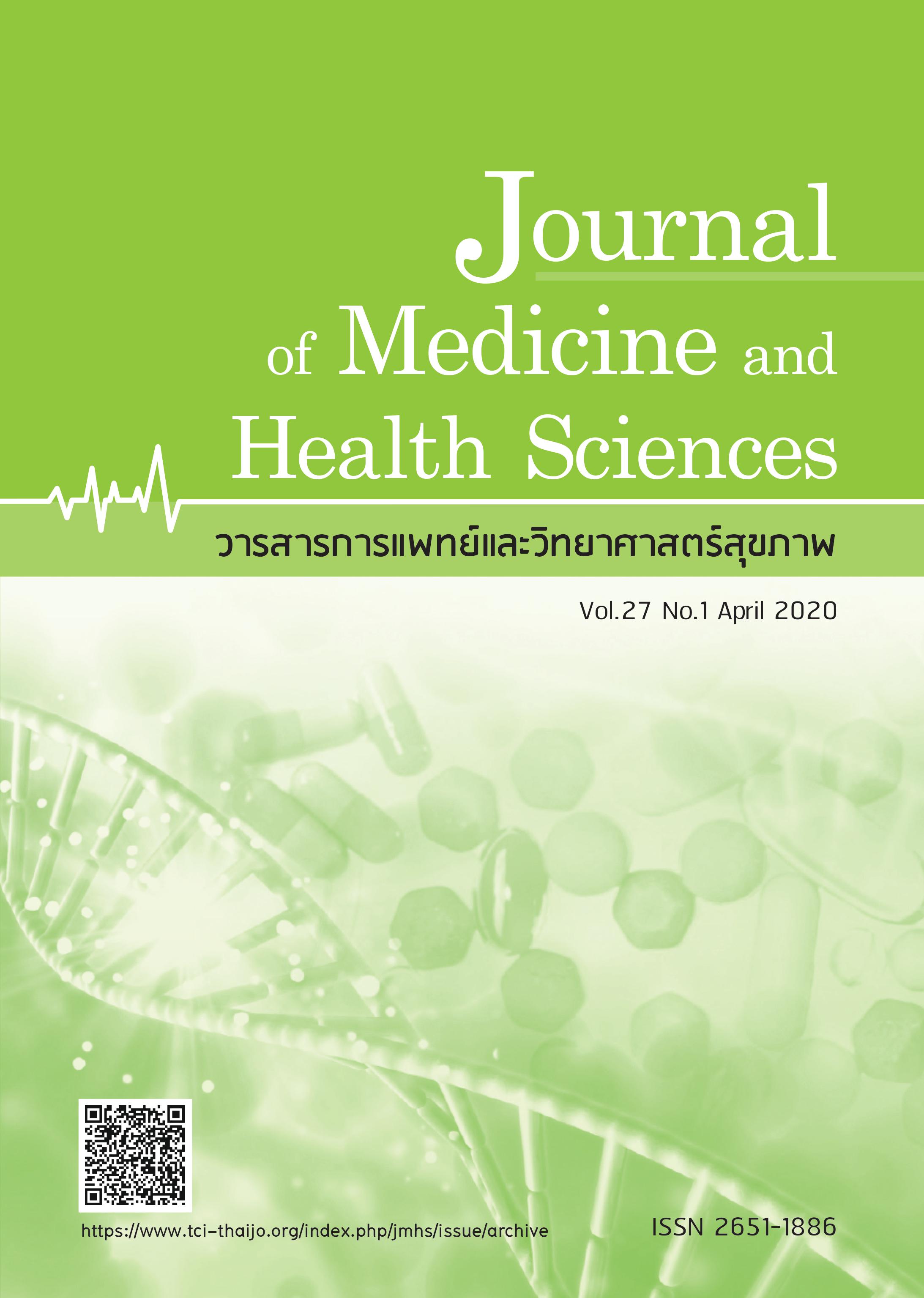ความสัมพันธ์ระหว่างปริมาณแคลเซียมและแมกนีเซียมในเลือดของสตรีตั้งครรภ์ และอาการตะคริวที่ขา
Keywords:
leg cramps, pregnancy, calcium, magnesiumAbstract
Abstract
Leg cramps occur 30 to 45 percents in pregnant women. They lead to insufficient sleep various pregnancy problems and poor quality of life. Recent studies had shown inconclusive results regarding leg cramps and calcium-magnesium supplement during pregnancy. However, no study had carried out the calcium or magnesium levels in pregnant women with leg cramps. The primary objective of this study is to compare the mean serum calcium and magnesium levels between women with and without leg cramps and the secondary objective is to define factors that associated with leg cramps during pregnancy. After the approval of the ethics committee, One hundred and seventy-eight participants were consecutively enrolled. The participants were divided in to leg cramps pregnancy and non-leg cramps pregnancy groups according to study criteria of cramping. All participants were interviewed including demographic data, pregnancy risk and leg cramps experience by trained staffs. On the Labor Day, 3 ml. of venous blood collection was taken. Serum calcium, magnesium, vitamin D (25-OHD) intact parathyroid hormone (iPTH), phosphate, ALP and albumin were analyzed. The statistical analysis was done using SPSS version 17. Our study showed no statistically significant different between serum calcium-magnesium levels in pregnant women with and without leg cramps and the only factor associated with leg cramps during pregnancy was history of leg cramps before pregnancy. In conclusion, the treatment of leg cramps in pregnancy evaluate case by case basic is recommended for appropriate treatment solution.
บทคัดย่อ
ตะคริว คือ การหดเกร็งของกล้ามเนื้อ ที่เกิดขึ้นได้ตามส่วนต่างๆ ของร่างกาย พบบ่อยบริเวณกล้ามเนื้อขา ร้อยละ 30-45 ของสตรีตั้งครรภ์มีอาการตะคริวที่ขาและอาจก่อให้เกิดปัญหาด้านการตั้งครรภ์ต่างๆ ตามมาได้ เช่น การนอนหลับที่ไม่เพียงพอและการคลอดก่อนกำหนด เป็นต้น การศึกษาวิจัยในปัจจุบันยังไม่สามารถสรุปผลเรื่องการรับประทานแคลเซียมหรือแมกนีเซียมเสริมเพื่อการรักษาอาการตะคริวที่ขาได้ และยังไม่มีการศึกษาวิจัยเกี่ยวกับระดับแคลเซียมและแมกนีเซียมในเลือดของสตรีตั้งครรภ์ที่มีอาการตะคริวที่ขาการวิจัยนี้มีวัตถุประสงค์เพื่อเปรียบเทียบปริมาณแคลเซียมและแมกนีเซียมในเลือดของสตรีตั้งครรภ์ที่เกิดอาการตะคริวที่ขาและสตรีตั้งครรภ์ที่ไม่มีอาการตะคริวที่ขา และปัจจัยที่ทำให้เกิดอาการตะคริวที่ขาในสตรีตั้งครรภ์งานวิจัยนี้ได้รับการรับรองจากคณะกรรมการจริยธรรมวิจัยในมนุษย์โรงพยาบาลชลประทาน สตรีตั้งครรภ์จำนวน178 คน ได้ถูกสุ่มคัดเลือกเป็นกลุ่มตัวอย่างเข้าร่วมในโครงการวิจัย โดยกลุ่มตัวอย่างถูกแบ่งออกเป็นสองกลุ่มคือ กลุ่มที่มีอาการตะคริวที่ขา และกลุ่มที่ไม่มีอาการตะคริวที่ขา กลุ่มตัวอย่างจะถูกสัมภาษณ์เกี่ยวกับข้อมูลพื้นฐานทั่วไป ความเสี่ยงที่มีระหว่างตั้งครรภ์ อาการตะคริวระหว่างตั้งครรภ์ และในวันที่กลุ่มตัวอย่างมาคลอดที่โรงพยาบาลชลประทาน ได้รับการตรวจเลือดเพื่อตรวจวัดระดับ แคลเซียม แมกนีเซียม วิตามินดี พาราไทรอยด์ฮอร์โมน ฟอสเฟต อัลคาไลน์ฟอสฟาเตส และอัลบูมิน ข้อมูลทั้งหมดได้นำมาวิเคราะห์ โดยใช้โปรแกรม SPSS version 17 ผลการวิจัยพบว่า ระดับแคลเซียม แมกนีเซียม ในกลุ่มที่มีอาการตะคริวที่ขาเปรียบเทียบกับกลุ่มที่ ไม่มีอาการตะคริวที่ขา ไม่มีความแตกต่างกันอย่างมีนัยสำคัญทางสถิติ ปัจจัยที่มีผลต่อการเกิดตะคริวที่ขาในระหว่างตั้งครรภ์คือ มีอาการตะคริวที่ขาก่อนตั้งครรภ์ ดังนั้น จากการวิจัยนี้ สรุปผลว่า การดูแลรักษาอาการตะคริวที่ขาในสตรีตั้งครรภ์ ควรจะพิจารณาถึงสาเหตุของการเกิดตะคริวก่อน เพื่อการรักษาที่ถูกต้องตรงตามสาเหตุในแต่ละราย
References
2. Brown TM. Sleep-Related Leg Cramps:A Review and Suggestions for Future Research. Sleep Med Clin 2015;10(3):385-92.
3. Lee KA, Gay CL. Sleep in late pregnancy predicts length of labor and type of delivery. Am J Obstet Gynecol 2004;191:2041-6.
4. Hammar M, Larsson L, Tegler L. Calcium treatment of leg cramps in pregnancy,effect on clinical symptoms and total serum and ionized serum calcium concentrations. Acta Obstet Gynecol Scand 1981;60:345-7.
5. Cunningham F.G. LKJ, Bloom S.L., Hualth J.C., et al. Maternal physiology. Williams Obstetrics. 25th ed. New york: McGraw-Hill;2018;p.57.
6. Rabbitt L, Mulkerrin EC, O’keffe ST. A review of nocturnal leg cramps in order people. Age Ageing 2016;45:776-82.
7. Young GL, Jewell D. Interventions for leg cramps in pregnancy. Cochrane Database of Systematic Reviews 2002;Issue1:Art. No.:CD000121.DOI:10.1002/14651858.CD000121.
8. Dahle LO, Berg G, Hammar M, et al. The effect of oral magnesium substitution on pregnancy-induced leg cramps. Am J Obstet Gynecol 1995;173:175-80.
9. Supakatisant C, Phupong V. Oral magnesium for relief in pregnancy-induced leg cramps: a randomised controlled trial. Matern Child Nur 2015;11:139-45.
10. Nygaard IH, Valbo A, Pethick SV, et al. Does oral magnesium substitution relieve pregnancy-induced leg cramps? Eur J Obstet Gynecol Reprod Biol 2008;141:23-6.
11. Hammar M, Berg G, Solheim F, et al. Calcium and magnesium status in pregnant women. A comparison between treatment with calcium and vitamin C in pregnant women with leg cramps. Int J Vitam Nutr Res 1987;57:179-83.



